A pension annuity works by providing a guaranteed income stream during retirement. It involves an agreement between an individual (the annuitant) and an insurance company. The annuitant typically contributes a lump sum or regular premiums to the insurer in exchange for regular payments. The amount of the annuity income is determined by various factors, including the annuitant's age, gender, and the amount of money invested. The insurer calculates the income payments based on actuarial calculations and factors such as life expectancy. Once the annuity is established, the annuitant receives regular payments, which can be fixed or variable depending on the terms of the annuity contract. The income continues for the duration of the annuitant's life or a specified period, providing financial security in retirement. The key aspects of pension annuities include the premium, death benefit, accumulation period, annuitization, and income phase. The premium is the amount paid to purchase the annuity. The death benefit is the amount that will be paid to the annuitant's beneficiaries if the annuitant dies before the income phase begins. The accumulation period is the time during which the premium grows tax-deferred. Annuitization is the process of converting the accumulated premium into a stream of income, while the income phase is the period during which the annuitant receives regular payments from the annuity. There are five main types of pension annuities: fixed, variable, indexed, immediate, and deferred. 1. Fixed Annuity: In a fixed annuity, the insurance company guarantees a fixed rate of return on the premium, and the annuitant receives regular payments of a fixed amount. 2. Variable Annuity: In a variable annuity, the premium is invested in a portfolio of securities, and the amount of income the annuitant receives depends on the performance of these investments. 3. Indexed Annuity: An indexed annuity is a type of fixed annuity where the rate of return is linked to the performance of a particular market index, such as the S&P 500. 4. Immediate Annuity: An immediate annuity is one where the income phase begins immediately after the premium is paid. 5. Deferred Annuity: In a deferred annuity, the income phase begins at some future date, allowing the premium to grow tax-deferred during the accumulation period. The acquisition of a pension annuity entails a careful examination of one's financial condition, the establishment of retirement objectives, and the selection of the most suitable annuity. Prior to investing in an annuity, one must thoroughly analyze their financial standing and retirement aspirations. This requires an estimation of post-retirement income requirements, a comprehension of risk acceptance levels, and contemplation of individual life expectancy and overall health status. The selection of an appropriate annuity requires thoughtful consideration of various factors. These encompass the insurer's financial stability, associated annuity fees, and potential payout options. Engaging with a trusted financial advisor or conducting comprehensive research ensures the choice aligns with the individual's retirement objectives. The purchasing stage typically consists of completing an application, determining the preferred type of annuity and payment options, and disbursing the premium. Upon approval, the contract is issued, and a schedule of payments for the annuity duration is received. Pension annuities come with both advantages and disadvantages, and understanding these can help individuals make informed decisions about whether an annuity is right for them. The main benefits of pension annuities include: Guaranteed Income: Annuities provide a guaranteed income stream, which can be particularly valuable for individuals who worry about outliving their savings. Protection Against Longevity Risk: By providing a lifetime income, annuities protect against the risk of outliving one's assets. Tax-Deferred Growth: The premiums paid into an annuity grow tax-deferred until they are withdrawn, which can help to accumulate more wealth over time. The main drawbacks of pension annuities include: Lack of Liquidity: Once invested in an annuity, the funds are usually not easily accessible without incurring penalties. High Fees: Annuities can come with high fees and charges, which can eat into the returns. Inflation Risk: The income from a fixed annuity might not keep up with inflation, reducing the purchasing power of the annuitant over time. Pension annuities can play a crucial role in retirement planning, offering a stable income stream and complementing other retirement income sources like Social Security and personal savings. A steady income stream is crucial in retirement, and a pension annuity can provide this. Annuities offer guaranteed income for life or a specified period, which can provide peace of mind and financial stability for retirees. Pension annuities can be an excellent tool for diversifying a retirement portfolio. By including an annuity in their portfolio, retirees can balance out riskier investments and secure a steady income, regardless of market conditions. Pension annuities offer tax-deferred growth, which means that taxes are not due on the growth of the annuity investment until the funds are withdrawn. However, once the funds are withdrawn, they are taxed as ordinary income. While annuities can provide a steady income in retirement, they are not without risks. However, these risks can be mitigated with careful planning and consideration. The main risks involved in pension annuities are insurer solvency risk, interest rate risk, and inflation risk. Insurer solvency risk is the risk that the insurance company might fail and be unable to make the promised payments. Interest rate risk refers to the possibility that interest rates might rise after you've locked in a fixed rate, reducing the purchasing power of your annuity payments. Inflation risk is the risk that inflation will erode the purchasing power of your fixed annuity payments over time. These risks can be mitigated through strategies such as diversification, investing in inflation-adjusted annuities, and choosing annuities with Guaranteed Lifetime Withdrawal Benefits (GLWB). 1. Diversification: By investing in a mix of annuities and other financial products, you can spread your risk and protect yourself against any one investment performing poorly. 2. Inflation-Adjusted Annuities: These annuities automatically adjust the payments to keep pace with inflation, protecting the purchasing power of your annuity income. 3. Guaranteed Lifetime Withdrawal Benefits (GLWB): Annuities with GLWB allow you to withdraw a certain amount from your annuity each year, providing flexibility and additional income. Pension annuities can be compared with other retirement income options, such as defined benefit plans, contribution plans, and Social Security. A defined benefit plan promises a specific monthly benefit at retirement, which is usually based on the employee's salary and years of service. A pension annuity, on the other hand, provides a guaranteed income based on the amount invested and the terms of the annuity contract. A defined contribution plans, like a 401(k) or an IRA, allows the individual to contribute a certain amount to a retirement account, and the account grows based on the performance of the investments within it. A pension annuity, in contrast, guarantees a specific income regardless of market performance. Social Security is a government program that provides retirement, disability, and survivor benefits. While Social Security benefits are based on the individual's earnings history, a pension annuity's payments are based on the amount invested and the annuity's terms. A pension annuity serves as a valuable tool for individuals planning for a secure retirement. By entering into a contract with an insurance company, retirees can ensure a steady income stream during their golden years. The five main types of pension annuities, fixed, variable, indexed, immediate, and deferred, offer diverse options to suit individual financial goals and needs. Pension annuities bring forth several pros, including guaranteed income, protection against longevity risk, and tax-deferred growth. However, it is essential to consider the cons as well, such as limited liquidity, potential high fees, and the risk of inflation eroding the purchasing power of payments. Careful consideration and research are crucial when purchasing a pension annuity, involving a comprehensive analysis of personal financial circumstances, retirement objectives, and the selection of a reputable insurer. Mitigating risks associated with annuities can be achieved through diversification, opting for inflation-adjusted annuities, and selecting annuities with guaranteed lifetime withdrawal benefits.Pension Annuity Overview
Key Aspects of Pension Annuity
Types of Pension Annuities
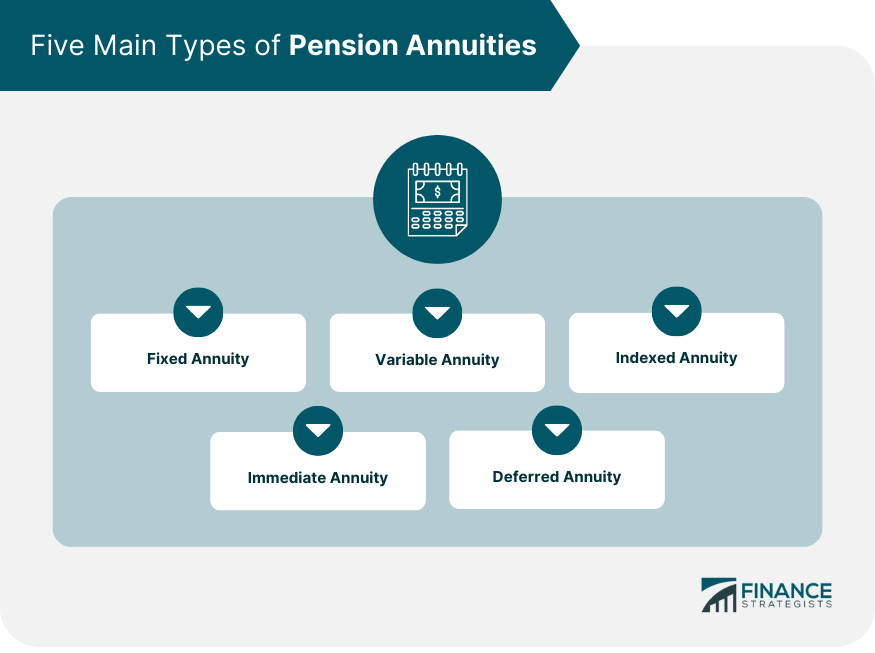
Process of Purchasing a Pension Annuity
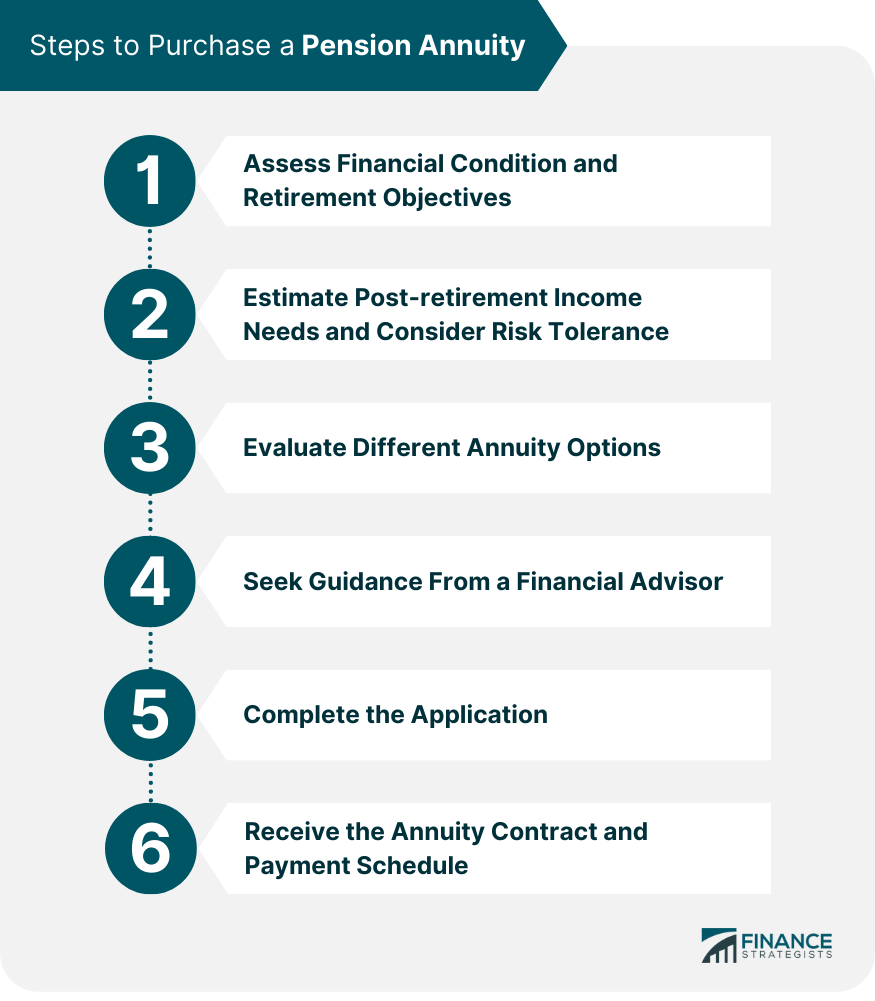
Pros and Cons of Pension Annuity
Pros of Pension Annuity
Cons of Pension Annuity
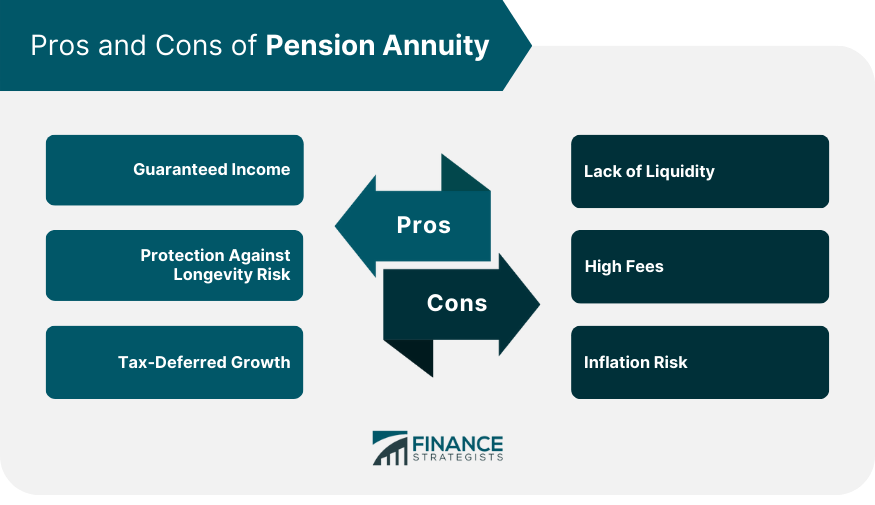
Role of Pension Annuity in Retirement Planning
Providing a Steady Income Stream
Diversifying Retirement Portfolio With Pension Annuity
Tax Implications of Pension Annuities
Risks and Mitigations in Pension Annuity
Risks Involved in Pension Annuity
Mitigation Strategies for Pension Annuity Risks
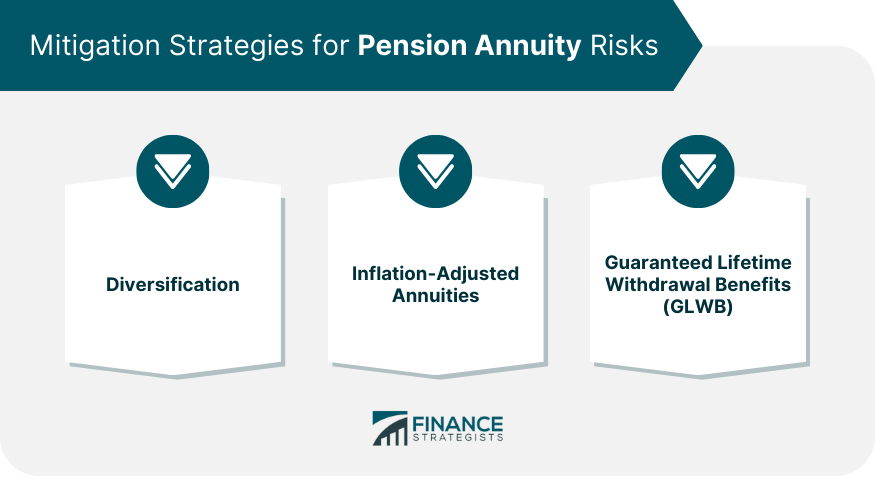
Comparison Between Pension Annuity and Other Retirement Options
Pension Annuity vs Defined Benefit Plan
Pension Annuity vs Defined Contribution Plan
Pension Annuity vs Social Security
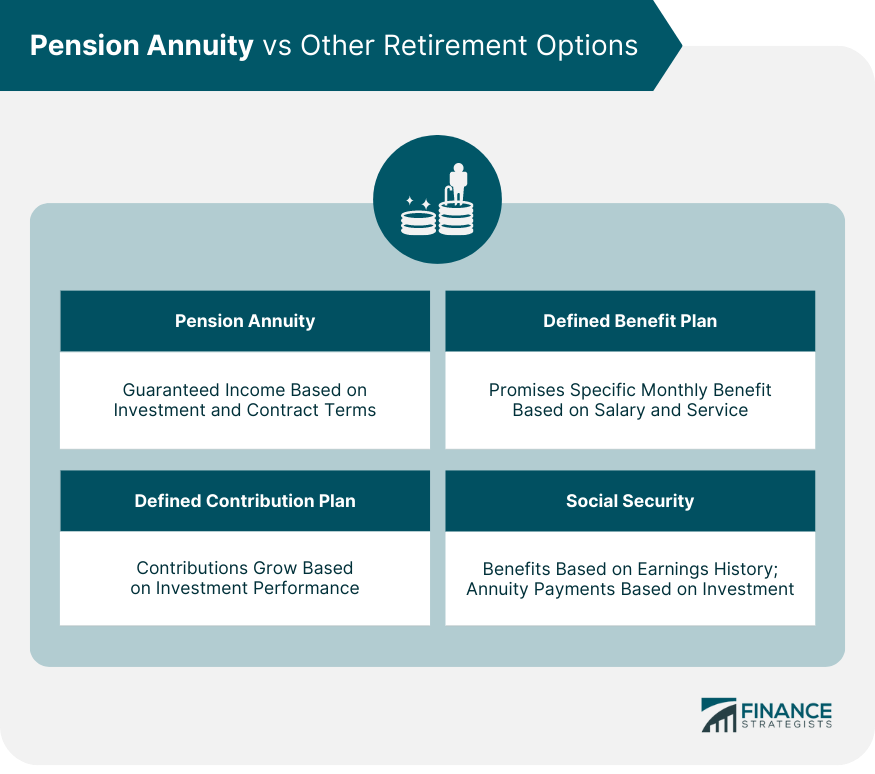
Bottom Line
Pension Annuity FAQs
The five main types of pension annuities are fixed, variable, indexed, immediate, and deferred. Fixed annuities guarantee a fixed rate of return, while variable annuities' returns depend on the performance of a portfolio of securities. Indexed annuities offer returns linked to a market index. Immediate annuities start payments right after purchase, while deferred annuities begin payments at a future date.
Pension annuities offer several benefits, including a guaranteed income stream, protection against longevity risk (outliving your savings), and tax-deferred growth of your investment. These features make them an attractive option for those seeking a steady income in retirement.
Key risks associated with pension annuities include a lack of liquidity (difficulty accessing your funds without penalties), high fees that can affect the return on your investment, and inflation risk (where the purchasing power of your annuity payments decreases over time due to inflation).
The process of purchasing a pension annuity involves assessing your financial situation, setting retirement goals, and selecting the right annuity. Once an annuity is chosen, the process typically involves filling out an application, selecting the annuity type and payment options, and making your premium payment.
Pension annuities offer a guaranteed income, which can complement other retirement income sources like Social Security and personal savings. Compared to defined benefit and defined contribution plans, the income from a pension annuity is based on the amount invested and the terms of the annuity contract, not on the individual's salary or years of service.
True Tamplin is a published author, public speaker, CEO of UpDigital, and founder of Finance Strategists.
True is a Certified Educator in Personal Finance (CEPF®), author of The Handy Financial Ratios Guide, a member of the Society for Advancing Business Editing and Writing, contributes to his financial education site, Finance Strategists, and has spoken to various financial communities such as the CFA Institute, as well as university students like his Alma mater, Biola University, where he received a bachelor of science in business and data analytics.
To learn more about True, visit his personal website or view his author profiles on Amazon, Nasdaq and Forbes.











